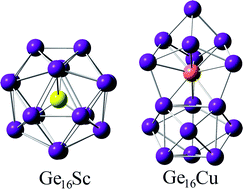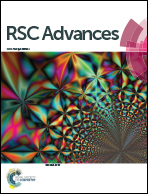First-row transition metal doped germanium clusters Ge16M: some remarkable superhalogens†
Abstract
A theoretical study of geometric and electronic structures, stability and magnetic properties of both neutral and anionic Ge16M0/− clusters with M being a first-row 3d transition metal atom, is performed using quantum chemical approaches. Both the isoelectronic Ge16Sc− anion and neutral Ge16Ti that have a perfect Frank–Kasper tetrahedral Td shape and an electron shell filled with 68 valence electrons, emerge as magic clusters with an enhanced thermodynamic stability. The latter can be rationalized by the simple Jellium model. Geometric distortions from the Frank–Kasper tetrahedron of Ge16M having more or less than 68 valence electrons can be understood by a Jahn–Teller effect. Remarkably, DFT calculations reveal that both neutral Ge16Sc and Ge16Cu can be considered as superhalogens as their electron affinities (≥3.6 eV) exceed the value of the halogen atoms and even that of icosahedral Al13. A detailed view of the magnetic behavior of Ge16M0/− clusters shows that the magnetic moments of the atomic metals remain large even when they are quenched upon doping. When M goes from Sc to Zn, the total spin magnetic moment of Ge16M0/− increases steadily and reaches the maximum value of 3 μB with M = Mn before decreasing towards the end of the first-row 3d block metals. Furthermore, the IR spectra of some tetrahedral Ge16M are also predicted.



 Please wait while we load your content...
Please wait while we load your content...